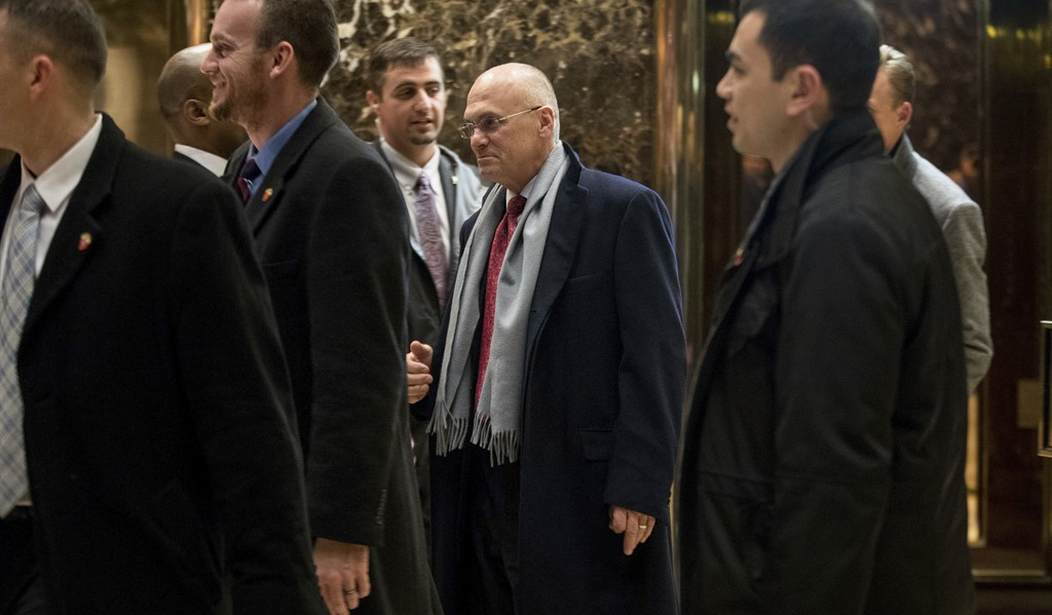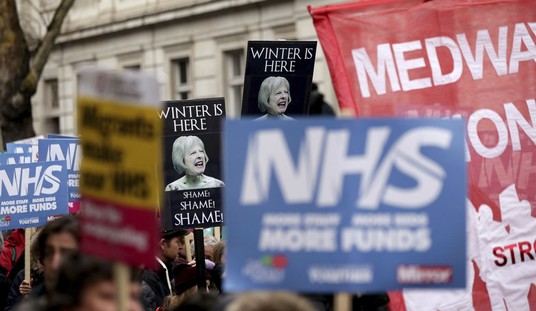Improved, yes, but does today’s data suggest that the economy is “markedly improving,” as one-time Labor Secretary nominee Andy Puzder argues? The second iteration of the first quarter’s annualized GDP growth rate doesn’t exactly paint a rosy picture. While the new estimate improves on the advance report of 0.7% annualized GDP growth, today’s interim report only boosts it to 1.2%. That’s not exactly a strong endorsement of rapid growth, and the revision actually paints a slightly more glum picture of business investment:
Real gross domestic product (GDP) increased at an annual rate of 1.2 percent in the first quarter of 2017 (table 1), according to the “second” estimate released by the Bureau of Economic Analysis. In the fourth quarter, real GDP increased 2.1 percent.
The GDP estimate released today is based on more complete source data than were available for the “advance” estimate issued last month. In the advance estimate, the increase in real GDP was 0.7 percent. With this second estimate for the first quarter, the general picture of economic growth remains the same; increases in nonresidential fixed investment and in personal consumption expenditures (PCE) were larger and the decrease in state and local government spending was smaller than previously estimated. These revisions were partly offset by a larger decrease in private inventory investment (see “Updates to GDP” on page 2).
The growth in PCEs still only came in at 0.6%, a little better than the advance estimate of 0.3%, but still a sharp drop from 2016Q4’s 3.5% annualized growth. Exports improved and imports declined a bit from last month’s figures, which probably accounts for most of the improvement. Final sales of domestic product went up more sharply to 2.2%, indicating again that some restocking of inventory has resumed, but for the most part this still looks pretty weak as an argument for being on the cusp of a major breakout.
On top of this report, the Census Bureau delivered a gloomy report on durable goods in April. It might just be a corrective from an unusually robust March, however:
New orders for manufactured durable goods in April decreased $1.6 billion or 0.7 percent to $231.2 billion, the U.S. Census Bureau announced today. This decrease, down following four consecutive monthly increases, followed a 2.3 percent March increase. Excluding transportation, new orders decreased 0.4 percent. Excluding defense, new orders decreased 0.8 percent. Transportation equipment, down following two consecutive monthly increases, led the decrease, $1.0 billion or 1.2 percent to $78.5 billion.
The outlook for business investment doesn’t look particularly good in April either:
Nondefense new orders for capital goods in April decreased $1.4 billion or 1.9 percent to $70.4 billion. Shipments decreased $0.4 billion or 0.5 percent to $69.7 billion. Unfilled orders increased $0.7 billion or 0.1 percent to $697.3 billion. Inventories decreased $1.2 billion or 0.7 percent to $176.7 billion. Defense new orders for capital goods in April increased $0.4 billion or 4.2 percent to $10.2 billion. Shipments increased $0.2 billion or 1.7 percent to $10.2 billion. Unfilled orders decreased less than $0.1 billion or virtually unchanged to $141.7 billion. Inventories increased $0.7 billion or 3.0 percent to $22.3 billion.
So is Puzder wrong? We’ll get to him in a moment, but he’s not necessarily alone. Reuters reports that this isn’t dimming expectations for Q2 results, but that the picture is still murky:
U.S. economic growth slowed less sharply in the first quarter than initially thought, but the weakness was likely an aberration amid a strong labour market that is near full employment. …
The Trump administration has proposed a range of measures to spur faster economic growth, including big tax cuts. But analysts are sceptical that fiscal stimulus, if it materializes, will fire up the economy given weak productivity and labour shortages in some areas.
There are signs GDP growth regained speed early in the second quarter, with industrial production accelerating in April. But hopes of a sharp rebound in growth have been tempered by weak business spending, a modest increase in retail sales last month, a widening of the goods trade deficit and decreases in inventory investment.
My friend King Banaian notes that the Atlanta Fed has tempered its Q2 outlook, but that it’s still expecting to see strength:
Atlanta Fed GDPNow 2nd-quarter forecast cut to 3.7% from 4.1% https://t.co/3iHp4abqyF #kbrs it was too high before, converging to reality
— King Banaian (@banaianshow) May 26, 2017
Puzder argues that the less-sexy fundamentals indicate a boom is coming:
In April the Index of Small Business Optimism, produced by the National Federation of Independent Businesses, posted its sixth straight month of historically positive feelings, “a hot streak not seen since 1983” during the Reagan Administration. That’s backed up by the IBD/TIPP Economic Optimism Index, which “gauges how confident consumers, workers and investors are in the pace and direction of the U.S. economy.” An index above 50 indicates optimism. For May, it came in at 51.3. That’s 2.1 points above the index’s 16-year average of 49.2.
It’s still early, but the economy is showing signs of real growth, too. In April the unemployment rate hit a 10-year low, while existing home sales surged to a 10-year high and U.S. industrial production registered its largest gain in three years.
Last Thursday the Labor Department announced that the number of people claiming unemployment insurance benefits dropped to its lowest level since November 1988. Even more impressive, the moving four-week average for this metric dropped to 1.95 million, its lowest level since January 1973, when it was 1.92 million. That’s even more impressive than it sounds, since there are 72 million more people in the labor force today.
All true, but so far it’s not showing up on the bottom line. In order to see a real economic boom, it has to eventually appear in GDP and production numbers, and thus far we’re still seeing slack in both. The durable goods report in particular suggests that we won’t see a breakout in Q2, and that’s a problem for other reasons. Trump’s budget relies on a sustained level of growth over the next ten years to pay for his supply-side economic program, as I wrote in my column for The Fiscal Times yesterday, and so far the numbers aren’t adding up:
The problem starts with an assumption built into the financial projections of the budget proposal from OMB chief Mick Mulvaney. Donald Trump campaigned on a promise to enact economic policies that would produce annual growth in gross domestic product (GDP) consistently higher than 3 percent. The US economy has not seen that level of growth in a single year since 2004, and not in consecutive years since the dot-com bubble period of 1996-2000, according to the Bureau of Economic Analysis, but that promise was key to Trump’s election – and he has to deliver on it to pay for some of his other initiatives.
That may be the problem. Mulvaney’s budget assumes an even higher level of growth over the next ten years. The Trump budget projects a constant rate of real GDP growth of 3 percent from 2021 to 2027, a rate that has not been sustained for that long in the last several decades, at least. As CNN Money notes, the 2004 peak came as part of the housing bubble and since the collapse, has never come close to sustained growth at that rate. …
Unfortunately, in this case, the extreme nature of the underlying assumptions of the budget, combined with the duplicative use of questionable revenue outcomes, undermines the credibility of this big ask. The pay-for on tax reform relies on a sustained rate of growth that the US hasn’t seen for a single year in two decades, which makes the cuts to safety-net programs a greater risk. The math doesn’t add up.
It’s pretty early in the Trump presidency to lay any of these results on his policies, most of which haven’t been implemented at all yet. This is overhang of existing tax and regulatory policies, and the clock hasn’t really started on the rapid growth promised by Trump. That’s one reason to remain cautious, and Puzder’s rose-colored take on the status quo seems odd, given both that and the numbers at hand. It might be smarter for the administration and its apologists to use this data less as evidence of their impact, and more as reasons to enact their tax and regulatory policies ASAP.








Join the conversation as a VIP Member